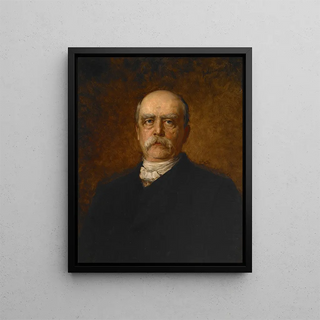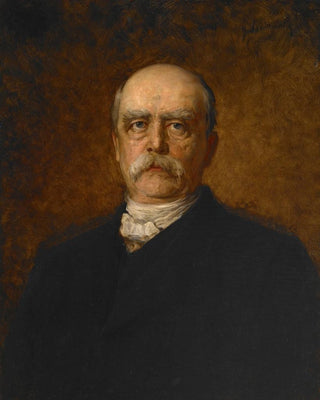Art print Portrait of Otto Eduard Leopold von Bismarck - Franz von Lenbach | Art print


View from behind

Frame (optional)
Introduction captivante
The "Portrait of Otto Eduard Leopold von Bismarck" by Franz von Lenbach is an iconic work that embodies the power and complexity of a man who profoundly shaped German and European history. Painted at the end of the 19th century, this portrait goes beyond a simple physical representation; it is a psychological exploration of the Iron Chancellor's personality. The canvas, rich in detail and emotion, invites us to delve into the universe of a man whose decisions have shaped the destiny of a nation. Through this portrait, Lenbach manages to capture not only Bismarck's appearance but also the aura that surrounds him, making him both accessible and distant.
Style and uniqueness of the work
Lenbach's style is characterized by striking realism, where each brushstroke seems imbued with a deep intention. In this portrait, mastery of chiaroscuro accentuates Bismarck's facial features, highlighting his determination and charisma. The rich colors and carefully crafted textures give the work a depth that draws the eye and inspires admiration. Lenbach, a true virtuoso, succeeds in bringing his subject to life, allowing the viewer to feel the strength of character emanating from Bismarck. The composition, both balanced and dynamic, creates a tension that captures attention and invites interpretation. This portrait does not merely freeze a moment; it tells a story, that of a man who knew how to navigate the tumult of his era with remarkable skill.
The artist and his influence
Franz von Lenbach, born in 1836, is one of the most renowned portraitists of his time. His career, marked by encounters with emblematic figures of the era, allowed him to develop a unique style that combines realism and idealization. Lenbach established himself in the art world by capturing not only the physical appearance of his subjects but also their essence. His work with Bismarck is particularly significant, as it demonstrates the relationship between art and power.

Matte finish

View from behind

Frame (optional)
Introduction captivante
The "Portrait of Otto Eduard Leopold von Bismarck" by Franz von Lenbach is an iconic work that embodies the power and complexity of a man who profoundly shaped German and European history. Painted at the end of the 19th century, this portrait goes beyond a simple physical representation; it is a psychological exploration of the Iron Chancellor's personality. The canvas, rich in detail and emotion, invites us to delve into the universe of a man whose decisions have shaped the destiny of a nation. Through this portrait, Lenbach manages to capture not only Bismarck's appearance but also the aura that surrounds him, making him both accessible and distant.
Style and uniqueness of the work
Lenbach's style is characterized by striking realism, where each brushstroke seems imbued with a deep intention. In this portrait, mastery of chiaroscuro accentuates Bismarck's facial features, highlighting his determination and charisma. The rich colors and carefully crafted textures give the work a depth that draws the eye and inspires admiration. Lenbach, a true virtuoso, succeeds in bringing his subject to life, allowing the viewer to feel the strength of character emanating from Bismarck. The composition, both balanced and dynamic, creates a tension that captures attention and invites interpretation. This portrait does not merely freeze a moment; it tells a story, that of a man who knew how to navigate the tumult of his era with remarkable skill.
The artist and his influence
Franz von Lenbach, born in 1836, is one of the most renowned portraitists of his time. His career, marked by encounters with emblematic figures of the era, allowed him to develop a unique style that combines realism and idealization. Lenbach established himself in the art world by capturing not only the physical appearance of his subjects but also their essence. His work with Bismarck is particularly significant, as it demonstrates the relationship between art and power.
12,34 €






